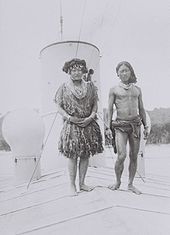Sipora
| Sipora | ||
|---|---|---|
| Sipora as part of the Mentawai Islands | ||
| Waters | Indian Ocean | |
| Archipelago | Mentawai Islands | |
| Geographical location | 2 ° 11 ′ S , 99 ° 38 ′ E | |
|
|
||
| surface | 845 km² | |
| Highest elevation | 285 m | |
| main place | Tua Pejat | |
Sipora (also called Sipura ) belongs to the Mentawai Islands , an island group south-west of Sumatra belonging to Indonesia .
geography
The island is about 130 km west of Sumatra, in the south, across the Strait of Selat Sipura , is Northern Pagai , in the north, beyond the Selat Bungalaut Siberut . Sipora is largely flat, the highest point being 285 m above sea level. The area of 845 km² is partly covered by tropical rainforests.
administration
Sipora is also a district ( Kecamatan ) of the 1999 formed government district ( Kabupaten ) Mentawai Islands with the capital Tua Pejat (on Sipora ) in the province of Sumatra Barat (Western Sumatra ).
population
After the last ice age, the island was separated from Sumatra by rising sea levels. Before 1000 BC Sipora was settled in the north by southern Siberut. The inhabitants differ from the inhabitants of Sumatra in terms of language and customs. In 2000 there were 12,840 residents here.
history
In 1792 a British East India Company ship reached and the first European set foot on the Pagai Islands. It was not until July 1864 that Sipora became part of the Dutch East Indies . In 1901 German missionaries reached the Mentawai Islands. Otherwise, the natives were largely left alone. That changed after Indonesia's independence when the indigenous animistic religion was banned. Today most of the residents are Christians. In the mid-1990s, Australian surfers discovered Sipora for surfing along with the other Mentawai Islands . Tourism is modest but growing.
After the seaquake off Sumatra in 2004, seismic activity under the island has increased significantly.
Animal world (fauna)
Several endemic animal species live on the island , including the Pagai macaque , whose population is now endangered.
Individual evidence
- ↑ a b UNEP Islands (English)
- ^ A b Narendra S. Bisht: Encyclopaedia of the South East Asian Ethnography. Global Vision, 2004, ISBN 978-81-87746-96-6 , p. 431. Restricted preview in Google book search
- ^ Siberut National Park In: indonesiatraveling.com


